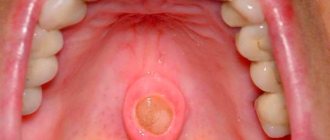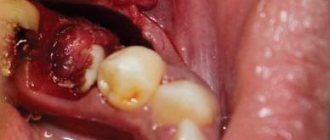Hairy leukoplakia of the mouth or tongue - symptoms and treatment
Content:
What is oral leukoplakia
Causes of leukoplakia in the oral cavity
Symptoms of hairy leukoplakia
What does hairy leukoplakia look like?
What are the dangers of leukoplakia?
How to treat hairy leukoplakia
Various diseases occur on the oral mucosa, which are a manifestation of reduced immunity. A common condition is hairy leukoplakia of the tongue.
Symptoms of HIV infection in the oral cavity
The herpes simplex virus is present in most people. The infection persists in the body throughout life and does not cause any special problems, except for rare rashes on the lips.
Herpetic gingivostomatitis
In HIV-infected people, herpes rashes are chronic with rare stages of remission. It is distinguished by blistering rashes around the mouth and on mucous tissues. When the vesicles open, painful erosions occur that develop into fairly large ulcers. The manifestation of herpes zoster and rashes in atypical places is also noticed.
Candidiasis
Candidiasis is also a common symptom of HIV infection and is chronic. Its symptoms are the same as with regular thrush, the only difference being that plaque covers most of the mouth.
Hairy leukoplakia
Clinical manifestations of the disease look like deformed mucous tissue, externally resembling folds or hairs. Localization area: lateral parts of the tongue and the inner surface of the cheeks. Painful sensations are usually absent.
HIV gingivitis and periodontitis
In this case, the infection manifests itself as acute inflammation of the gums. Starting with ordinary bleeding gums, the disease quickly develops into an acute form. With adequate treatment, tooth loss can be avoided.
Kaposi's sarcoma
This is one of the most characteristic symptoms of HIV infection in the clinical stage of manifestation. The tumor is formed from lymphatic vessels, in the mouth it is located near the root of the tongue, less often on the gums.
What is oral leukoplakia
Leukoplakia is a lesion of the oral mucosa in which excessive keratinization is observed. Located on the cheeks, hard and soft palates, and tongue.
Types of leukoplakia:
- Flat is the most common form. Usually does not cause discomfort. Discovered by chance at a dental appointment.
- Verrucous - more pronounced keratinization than with the flat form. Patients note a feeling of roughness and tightness on the mucous membrane, a burning sensation.
- Erosive – is a complication of the previous two forms when exposed to a traumatic factor. Characterized by pain. which occurs when talking or eating.
- Hairy leukoplakia is a disease caused by the Epstein-Barr virus. Often observed in patients with HIV.
- Tappeiner's leukoplakia - it is found in long-term smokers. It is observed on the soft and hard palate.
Some forms of this disease are considered precancerous. If left untreated, they develop into malignant tumors. Therefore, it is important to contact a dental clinic in Moscow when you first detect pathological changes in the mucous membrane.
Clinic
The incubation period for HIV infection is 1–3 months, but can be longer. After this, the initial stage of the disease develops, called acute HIV infection.
Only 20% of infected people develop clinical signs in the form of a general infectious syndrome of an undifferentiated nature (mononucleosis-like manifestations, serous meningitis, encephalopathy, myelopathy or neuropathy).
A clinically favorable outcome of the acute stage of the disease does not mean either the acquisition of immunity or recovery, despite seroconversion. The disease progresses to a chronic stage, which occurs either subclinically or in the form of persistent generalized lymphadenopathy with a constant subtle transition to the AIDS-associated syndrome.
Patients remain active, productive and in good health. There are no signs of immunosuppression yet.
Prognostically unfavorable is a decrease in the size of the lymph nodes, which means involution of the follicles - a morphological sign of immunosuppression.
Clinical symptoms of the AIDS-associated stage of the disease consist of signs of initial immune deficiency. They are manifested by local infections of the skin and mucous membranes caused by low-pathogenic representatives of microflora of an opportunistic nature (viral and bacterial stomatitis, pharyngitis, sinusitis, oral, genital, perianal herpes, recurrent herpes zoster, candidal stomatitis, genital and perianal candidiasis, dermatomycosis of the feet, legs, impetigo , acne folliculitis, hairy leukoplakia of the tongue, etc.).
Lesions of the skin and mucous membranes are initially easily amenable to conventional therapy, but quickly recur and gradually become chronically recurrent in nature. The most important feature of the clinical picture of the AIDS-associated complex is the steady increase in symptoms with the worsening of existing lesions and the appearance of new lesions.
The chronic stage of the disease gradually moves into its final stage - AIDS. By this time, immune functions are suppressed and disturbed to the maximum (CD-4 lymphocytes are reduced to 100 per 1 mm3).
According to available observations, 5 years after infection, from 25 to 50% of people develop AIDS, after 7 years - up to 75%, after 10 years (observations since 1981) - slightly more than 90% of those infected. Can the remaining 10% not get sick? They can if the latent period of the disease turns out to be longer than the remaining years of their life.
Infections - the most common and dangerous manifestation of AIDS - develop in the form of localized, generalized and septic forms. The skin, mucous membranes, and internal organs are affected.
The clinical features of infectious processes in AIDS are their increasing nature, prevalence, severity, atypical symptoms and multiplicity of localizations.
The main diseases that manifest themselves in AIDS on the oral mucosa, depending on the etiotropic factor, are grouped as follows.
1. Fungal infections:
- candidiasis (pseudomembranous, erythematous, hyperplastic - in the form of a plaque or nodes, angular cheilitis);
- histoplasmosis.
2. Bacterial infections:
- fusospirochetosis (ulcerative-necrotizing gingivitis);
- nonspecific infections (chronic periodontitis);
- mycobacteria, enterobacteria.
3. Viral infections:
- herpetic stomatitis;
- hairy leukoplakia;
- herpes zoster (shingles);
- xerostomia caused by cytomegalovirus.
4. Neoplasms:
- Kaposi's sarcoma in the oral cavity;
- squamous cell carcinoma;
- Non-Hodgkins lymphoma.
5. Lesions of unknown etiology:
- recurrent ulcerating aphthae;
- idiopathic thrombocytopetic purpura (ecchymoses);
- lesions of the salivary glands.
Causes of leukoplakia in the oral cavity
To date, scientists have not reached a consensus on why the disease occurs. There are factors that can lead to the development of excess keratinization:
- Constant exposure to irritating factors: smoking, regular burns from hot food, strong alcohol, etc.
- Work in industries where there are chemicals, alkalis, acids.
- Living in a hot, dry climate.
- Taking drugs that reduce immunity.
- Local traumatic factors: failed fillings, sharp edges of dentures and damaged teeth, poor-quality braces.
- Endocrine pathologies: diabetes mellitus, hyperthyroidism, hypothyroidism.
- Reduced immunity: HIV, AIDS, immunosuppressive state. Oral hairy leukoplakia is often observed in patients with HIV and AIDS.
Causes of leukoplakia
The causes of leukoplakia usually lie in damage to the mucous membrane. This may occur as a result of the following factors:
- Violation of the integrity of the mucous membranes. Scratches and wounds resulting from an incorrect bite, biting the cheeks, sharp edges of the teeth due to chipped enamel or incorrectly installed dentures.
- Irritation of the mucous membrane by food - sour, spicy, too salty foods, dishes of extreme temperatures can also provoke microdamage to tissues. Alcohol, tobacco smoke and chewing tobacco also irritate tissues.
- Irritation by galvanic currents - metal crowns increase the risk of developing leukoplakia.
- Occupational hazard. Work in chemical production, work with paints and varnishes, resins, etc. can have a negative effect on mucosal cells.
- Exposure to stomach acid. Gastroesophageal reflux, bulimia and other diseases can reduce the resistance of the mucous membranes and irritate them, increasing the likelihood of developing the disease.
- Decrease in general defenses. Vitamin deficiency, the use of antibiotics, previous operations and severe infections, hypothermia, hormonal diseases, menopause and many other factors that contribute to decreased immunity can be the main or aggravating factors in the development of the disease.
Heredity also matters - researchers have found that the disease more often affects people whose close relatives have leukoplakia of the oral mucosa.
This disease is precancerous, so at the slightest suspicion it is important to consult a dentist.
Ask a Question
How to treat hairy leukoplakia
Before starting treatment, you need to conduct a number of studies. The patient is referred to a therapist at the clinic. There, the doctor can prescribe laboratory tests: biochemical blood test, testing for sexually transmitted diseases, etc.
If a person is diagnosed with HIV infection, antiretroviral therapy is administered. With long-term use of drugs, the patient’s well-being improves, and the disease in the mouth goes away.
The dental clinic provides oral examinations, dental diagnostics, and professional hygiene. If sharp edges of fillings or failed prostheses are detected, they are replaced. Treatment of caries and its complications is carried out. Recommendations are given for home dental care: personal hygiene products (brushes, pastes, dental floss, rinses) are selected.
Keratolytic drugs are suitable for local treatment. In advanced cases, they resort to surgical manipulations: excision of the affected areas with a laser.
Diagnosis for suspected HIV infection
For differentiated diagnosis of HIV infection from similar dental diseases, the following tests are used:
- Blood test for PCR reaction (aimed at detecting HIV).
- Immunoblotting technique.
- Linked immunosorbent assay.
- Checking immune status.
If the results are unclear, additional blood tests, as well as bacteriological studies, may be prescribed. Early diagnosis of the root cause of diseases can significantly alleviate the course of the disease.
Prevention
The best means of preventing any disease associated with the oral cavity are careful hygiene, a healthy lifestyle and giving up bad habits. In addition, to prevent leukoplakia from developing, prevention should consist of the manufacture and installation of high-quality dentures in a trusted clinic. Regular sanitation of the oral cavity, treatment of damaged teeth and preventive examinations at the dentist will prevent the development of the disease or at least detect it in the early stages.
Reasons for development
The main cause of leukoplakia of the tongue is considered to be the presence of the Einstein-Barr virus in the human body; it is the most common on the planet (at least 95% of the entire population has suffered from the diseases caused by the virus). The agent is transmitted mainly through biological fluids, often through saliva.
No wonder the main pathology it causes, infectious mononucleosis, is called the kissing disease. However, this disease most often affects children and adolescents, while adult patients develop immunity to mononuclear infection by the age of 25.
If a person’s immunity is not reduced, and infection with the Epstein-Barr virus does occur, leukoplakia can be practically asymptomatic, but associated diseases often develop against the background of this pathology. These include lymphogranulomatosis (a malignant lesion of lymphoid tissue) and Burkitt's lymphoma (the hematopoietic system is affected here, and the disease has an extremely unfavorable prognosis).
In addition to the fact that hairy leukoplakia is diagnosed in almost all patients with HIV infection, the following factors can lead to its development:
White coating on the root of the tongue
- abuse of tobacco products;
- tongue cancer;
- blood diseases, such as leukemia;
- regular negative effects on the oral mucosa of ultraviolet rays;
- deficiency of vitamins B and A in the body;
- constant irritation and injury to the soft tissues of the gums, lips, cheeks and tongue due to crooked teeth, crowns, bridges, incorrectly installed braces and dentures;
- autoimmune diseases - HIV, AIDS, rheumatoid arthritis, diabetes;
- hormonal imbalances;
- long-term use of medications that strongly suppress the immune system.
When the Epstein-Barr virus enters the body, especially if the patient is over 45 years old, tends to smoke and has chronic diseases, the immune system becomes defenseless, which leads to active replication of the enemy agent. In such situations, the manifestations of hairy leukoplakia will be striking and will force the patient to urgently consult a doctor.
Pathology can be caused by several types of viruses










